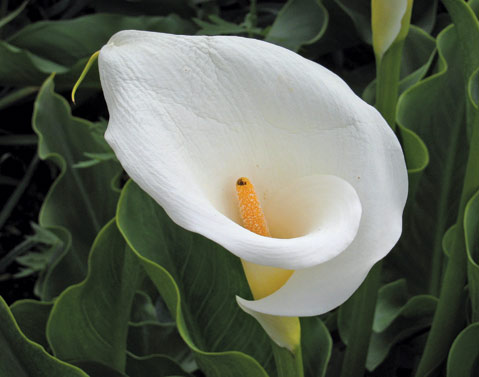Geophytes
Ground-Dwellers Awakened by the Rain

Many, if not most, flowering plants spend the year clothed in green and standing tall above the earth. For another group, the majority of their biomass is sequestered below ground for varying amounts of time. They are commonly referred to as bulbs. Narcissus bulbs push up their thin green spears in late winter and spring, flower, and then wither and disappear for months on end. Tulips and hyacinths have been garden favorites for decades, even centuries. There is another group of these ground-dwellers that spend even more of their life as a swollen underground stem. They are sometimes referred to as geophytes (geo = the earth and phyte = plant).
Some of the most handsome and best-adapted for southern California are native to similar climates in Southern Africa. A few are quite common now, but others are deserving of wider distribution. Calla lily (Zantedeschia aethiopica) is one of those ubiquitous ones. With no supplemental water, it will die back completely in summer only to miraculously reappear after the first rains. Severe frosts may damage it, but the white cones of its inflorescences seem invincible to almost everything (well, slugs and snails can disfigure them, but that’s another story). Glossy green arrowhead-shaped leaves may reach more than two feet in height, and the lilies overtop them for a pristine display. The green-lipped variety ‘Green Goddess’ is even more robust, but the true giant of the species is the cultivar known as ‘Hercules.’
Not quite as well-known, but coming up on the charts, is Veltheimia bracteata. Its South African common name is forest lily, alluding to the fact that it grows in the understory of coastal forest lands. Its appearance is also relatively brief; a bright green rosette of wavy-edged leaves emerges just before the flower spike. On top of this succulent stem, a number of pale coral tubular flowers dangle in a manner reminiscent of red hot pokers (Kniphofia). It is very often self-fertile and will have attracted some pollinator that results in an inflated papery seed pod with a few shiny black seeds inside. Sow them in regular potting medium to increase the population, or share with neighbors. Bulbs may be divided but may take several years to flower again.
Blood lily (Scadoxus multiflorus var. katherinae) is in the amaryllis family, and its flowers come in large showy umbels. Many short stalks radiate out from the apex of the flower stalk; each is terminated by a few narrow petals and many stamens. The color is not exactly as shocking as its name implies; rather, the flowers are a deep salmon red. Sturdy foliage surrounds this floral display and may merely diminish in size and not disappear entirely if supplemental water is given.
A close relative of blood lily is the genus Haemanthus. There are several species to be found without too much effort. The winter-flowering one is H. coccineus. This species sends up naked flower stalks topped with a plethora of scarlet flowers (mostly consisting of stamens) in a rounded inflorescence surrounded by very showy bracts. Long after the flowers have wilted and gone, the bulb then sends up several wide, leathery leaves.
All these geophytes are nearly carefree, and most of them can grow in at least partial shade. So here are some species that not only reliably return from their summer dormancy but can do it under other trees and shrubs that prefer no water except that which naturally falls during the winter months. Miraculous, indeed.



